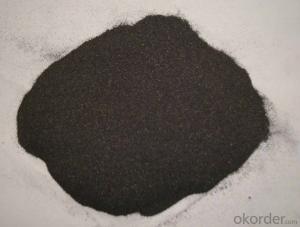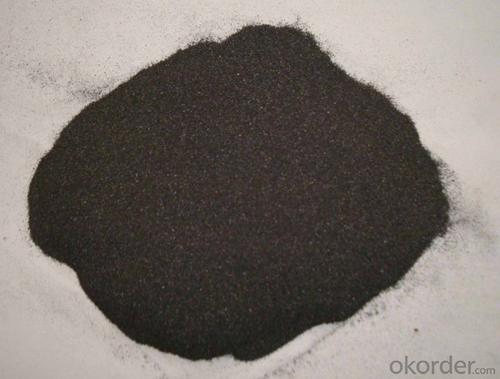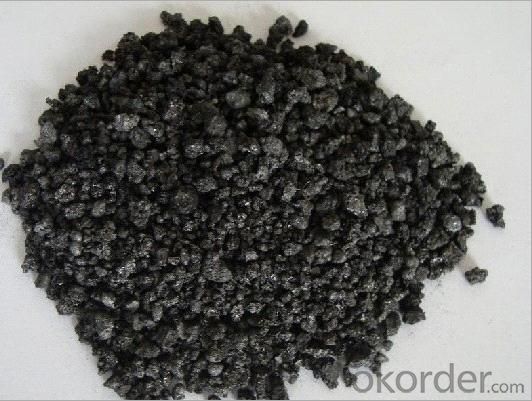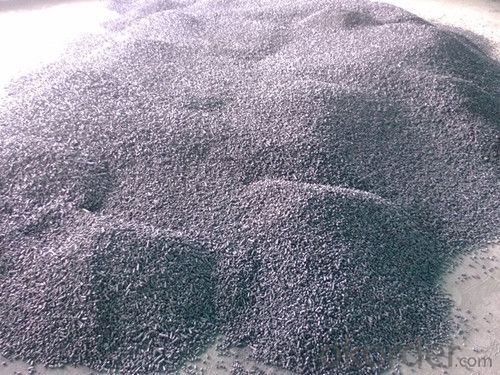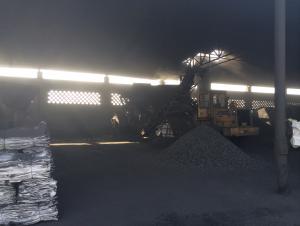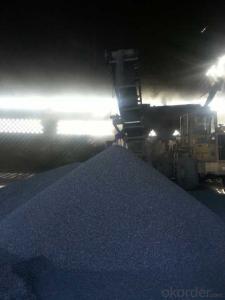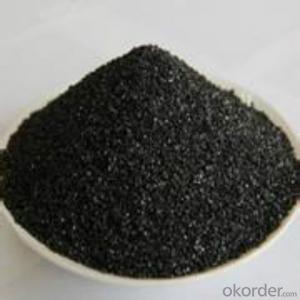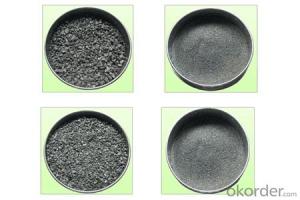Carbon Additive FC 92% CNBM For Steelmaking
- Loading Port:
- Tianjin
- Payment Terms:
- TT OR LC
- Min Order Qty:
- 0 m.t.
- Supply Capability:
- 100000 m.t./month
OKorder Service Pledge
OKorder Financial Service
You Might Also Like
Our Products:
•Feature: All of our goods are made in the best quality of world famous Tianjin. All of our products are with High carbon, Low ash, low sulphur, Low Moisture.
•Application:
The Calcined Anthracite Coal/Gas Calcined Anthracite Coal/Carbon Raiser is mainly used in steelmaking in electrical stove, screening water, shipbuilding sandblast to remove rust. It can reduce the cost of steelmaking effectively by replacing the traditional petroleum coke of carburant.Also can improve the Carbon content in steel-melting and Ductile iron foundry.
Packaging & Delivery
| Packaging Detail: | 25kgs/50kgs/1ton per bag or as buyer's request |
| Delivery Detail: | Within 20 days after receiving corect L/C |
Specifications
Calcined Anthracite
Fixed carbon: 90%-95%
S: 0.5% max
Size: 0-3. 3-5.3-15 or as request
PARAMETER UNIT GUARANTEE VALUE | |||||
F.C.% | 95MIN | 94MIN | 93MIN | 92MIN | 90MIN |
ASH % | 4MAX | 5MAX | 6MAX | 7MAX | 8MAX |
V.M.% | 1 MAX | 1MAX | 1.5MAX | 1.5MAX | 1.5MAX |
SULFUR % | 0.5MAX | 0.5MAX | 0.5MAX | 0.5MAX | 0.5MAX |
MOISTURE % | 0.5MAX | 0.5MAX | 0.5MAX | 0.5MAX | 0.5MAX |
Size can be adjusted based on buyer's request.
Pictures of Calcined Anthracite:

- Q: Is carbon a metal or non-metal?
- Carbon is a non-metal.
- Q: How does deforestation contribute to carbon dioxide levels in the atmosphere?
- Increased carbon dioxide levels in the atmosphere are significantly influenced by deforestation. Trees play a crucial role as natural carbon sinks, absorbing carbon dioxide through photosynthesis and storing it in their trunks, branches, and leaves. However, when forests are cleared or burned down for purposes like agriculture, logging, or urbanization, the stored carbon is released back into the atmosphere as carbon dioxide. The removal of trees directly diminishes the planet's ability to absorb carbon dioxide, resulting in an imbalance in the carbon cycle. Furthermore, deforestation disrupts the carbon cycle by hindering the process of photosynthesis, which is vital for converting carbon dioxide into oxygen and organic compounds. Additionally, deforestation indirectly contributes to increased carbon dioxide levels in the atmosphere through the decomposition of organic matter. When trees are cut down or burned, the stored carbon they contain is released as carbon dioxide, intensifying greenhouse gas emissions. Moreover, deforestation impacts the water cycle, leading to dryer conditions in affected areas. This causes soil to become arid, making it less suitable for plant growth and reducing the potential for carbon absorption through reforestation efforts. The cumulative effect of deforestation on carbon dioxide levels is significant. Studies indicate that deforestation accounts for approximately 10-15% of global carbon emissions, thus making it one of the leading contributors to climate change. The rise in atmospheric carbon dioxide levels, along with other greenhouse gases, contributes to the greenhouse effect, trapping heat in the atmosphere and causing global warming. To mitigate climate change and decrease carbon dioxide levels, it is crucial to address deforestation. Implementing sustainable forestry practices, promoting reforestation efforts, and protecting existing forests are essential steps in preserving carbon sinks and reducing greenhouse gas emissions.
- Q: How about Zonta carbon technology
- The factory garbage to death, wages do not rise, but down, quarterly awards fell by more than half, production targets set very high, employees can not reach the goal, not to work overtime. This is a company's way of restricting employees to work overtime. And so on, the target production has been added, so never meet the requirements, overtime do not think. A large piece of employee turnover now
- Q: How about carbon content of coal ash?
- Ash, carbon content, ash, carbon content, ash, carbon content, ash, carbon content, determination, determination, determination, determination (determination, determination)1 sampling(1) in the different positions of the ash, 7-10 points are deep to collect ash and 2-3kg. When sampling, not intentionally pick or avoid channels of ash, namely as ash samples taken, regardless of its size, regardless of the depth of color, regardless of its hardness, as far as possible to obtain a fully representative sample.(2) slag made on thick steel plate clean, which is smashed big gray block, mixing evenly into a cone, flattened, with a shovel cut ten sub center line, which is divided into 4 parts, two samples of diagonal, the other half abandoned.(3) repeat (2) operation. Reduce the amount to several times, until the ash is reduced to about 50 grams. Bring the ash back to the laboratory. The abandoned ash is discharged back into the ash heap.2, sample preparation(1) the ash in the laboratory will be retrieved and dried in a heated air drying oven (about 1 hours) at 105-110 degrees centigrade.(2) crushing the dry ashes with the disc vibrating mill, and the fine ash powder is the analysis sample.
- Q: What is the carbon emission of the air conditioner?
- Summer less air-conditioning 1 hours, it will reduce carbon emissions of 0.621kg
- Q: What are the impacts of carbon emissions on the stability of deserts?
- Carbon emissions have a significant impact on the stability of deserts. Increased levels of carbon dioxide in the atmosphere contribute to global warming, leading to higher temperatures and altered precipitation patterns. These changes can intensify desertification processes, such as soil erosion and water scarcity, further destabilizing desert ecosystems. Additionally, carbon emissions from human activities, such as fossil fuel combustion, contribute to air pollution, which can harm desert flora and fauna, disrupting their ecological balance and overall stability.
- Q: What are the effects of carbon emissions on the stability of wetlands?
- The stability of wetlands is significantly impacted by carbon emissions. One of the main consequences is the disruption of the hydrological cycle, which can disturb the delicate balance of water levels in wetland ecosystems. The increased release of carbon emissions contributes to climate change and global warming, resulting in higher temperatures and changed patterns of precipitation. These alterations can lead to more frequent and severe droughts, floods, and storms, negatively affecting the stability of wetlands. Moreover, elevated levels of carbon dioxide also influence the vegetation in wetlands. Excess carbon dioxide can stimulate the growth of specific plant species, causing an imbalance in the wetland ecosystem. This imbalance can lead to the dominance of invasive species, which outcompete native plants and disrupt the natural biodiversity of the wetland. Consequently, the stability of the wetland is impacted as it relies on a diverse range of plant species to support the intricate web of life within it. Additionally, carbon emissions contribute to the acidification of water bodies, including wetlands. Increased carbon dioxide dissolves in water, forming carbonic acid, which lowers the pH of the water. Acidic conditions can be harmful to the survival of many wetland species, including plants, amphibians, fish, and invertebrates. The acidification of water can also result in the release of toxic metals and other pollutants from surrounding soils, further compromising the stability and health of wetland ecosystems. Lastly, carbon emissions contribute to the rise of sea levels due to the melting of polar ice caps and expansion of ocean waters. This poses a significant threat to coastal wetlands, which are particularly vulnerable to sea-level rise. As sea levels increase, there is a risk of saltwater intrusion, leading to the degradation and loss of freshwater wetlands. This loss can cause the displacement or extinction of numerous plant and animal species that depend on these ecosystems, ultimately destabilizing the wetland. In conclusion, the stability of wetlands is profoundly impacted by carbon emissions. From the disruption of the hydrological cycle and alteration of vegetation composition to the acidification of water and sea-level rise, these emissions pose a significant threat to the health and integrity of wetland ecosystems. It is essential to reduce carbon emissions and implement measures to protect and restore wetlands to ensure their stability and preserve the invaluable services they provide.
- Q: How does carbon dioxide affect the growth of marine organisms?
- Marine organisms are impacted by carbon dioxide in various ways. To begin with, the ocean's pH can be lowered by increased levels of carbon dioxide, causing ocean acidification. This change in acidity can harm the growth and development of marine organisms, particularly those with calcium carbonate shells or skeletons, such as corals, mollusks, and certain plankton species. Organisms like these may struggle to construct and maintain their structures due to high carbon dioxide levels, rendering them more susceptible to predation and hindering their overall growth and survival. Moreover, the physiology and metabolism of marine organisms can also be affected by elevated carbon dioxide levels. Research suggests that excessive carbon dioxide can disrupt the functioning of enzymes that are responsible for various biological processes, including growth and reproduction. This disruption can result in reduced growth rates, impaired reproductive success, and an overall decline in the fitness of marine organisms. Furthermore, increased carbon dioxide levels can indirectly impact marine organisms by modifying the availability and distribution of other vital nutrients and resources. For instance, heightened carbon dioxide can alter the solubility of minerals and trace elements, impacting their bioavailability to marine organisms. This disruption can disturb nutrient cycling and limit the availability of essential nutrients necessary for growth and development. In summary, the rise in carbon dioxide levels caused by human activities can have significant adverse effects on the growth and development of marine organisms. These effects can disrupt entire marine ecosystems, potentially leading to severe consequences for biodiversity and the functioning of these ecosystems.
- Q: What are the effects of carbon emissions on the stability of urban infrastructure?
- Urban infrastructure stability is significantly impacted by carbon emissions. The atmosphere is polluted with carbon dioxide and other greenhouse gases from different sources like industrial activities, transportation, and energy production, resulting in climate change. This, in turn, poses numerous challenges to urban infrastructure. Among the primary effects of carbon emissions on urban infrastructure stability is the increased frequency and severity of extreme weather events. Climate change leads to more intense heatwaves, storms, hurricanes, and flooding, causing substantial damage to buildings, roads, bridges, and other infrastructure components. Higher temperatures also cause materials to expand and contract, resulting in structural issues and reduced durability. Additionally, rising sea levels caused by carbon emissions contribute to the melting of polar ice caps, putting coastal cities at risk of flooding and erosion. This threatens critical infrastructure in these areas, such as ports, water treatment facilities, and transportation systems. The stability of urban infrastructure is compromised as sea levels continue to rise. Carbon emissions also impact energy supply and demand, affecting urban infrastructure stability. Climate change leads to extreme weather events that disrupt power grids and energy infrastructure, resulting in blackouts and service disruptions. Moreover, the increased demand for cooling systems due to rising temperatures can strain existing infrastructure and overload the electrical grid. Furthermore, carbon emissions contribute to air pollution, which negatively affects the health and well-being of urban populations. Poor air quality leads to respiratory and cardiovascular diseases, impacting the workforce and productivity. This indirectly affects the stability of urban infrastructure, as a healthy and productive population is crucial for the functioning of cities. To mitigate the effects of carbon emissions on urban infrastructure stability, various measures can be implemented. These include transitioning to renewable energy sources, improving energy efficiency in buildings and transportation, implementing sustainable urban planning strategies, and investing in climate-resilient infrastructure. These actions can reduce carbon emissions and build infrastructure capable of withstanding the challenges posed by climate change, ultimately ensuring the stability and resilience of urban areas.
- Q: The difference between double offset paper and carbon free printing paper
- In general, we use office A4, A3, B5 and other specifications of office paper are better offset paper, excellent offset paper to UPM and APP for the domestic leader.55G-140G grams in general, some mills also produce high grams, generally belongs to industrial paper!Carbon free copy is just typing paper and coating. Paint is divided into two kinds, one kind of colored, one kind of colorless.Generally for 37G, 45G, 52G and other grams.
Send your message to us
Carbon Additive FC 92% CNBM For Steelmaking
- Loading Port:
- Tianjin
- Payment Terms:
- TT OR LC
- Min Order Qty:
- 0 m.t.
- Supply Capability:
- 100000 m.t./month
OKorder Service Pledge
OKorder Financial Service
Similar products
Hot products
Hot Searches
Related keywords
